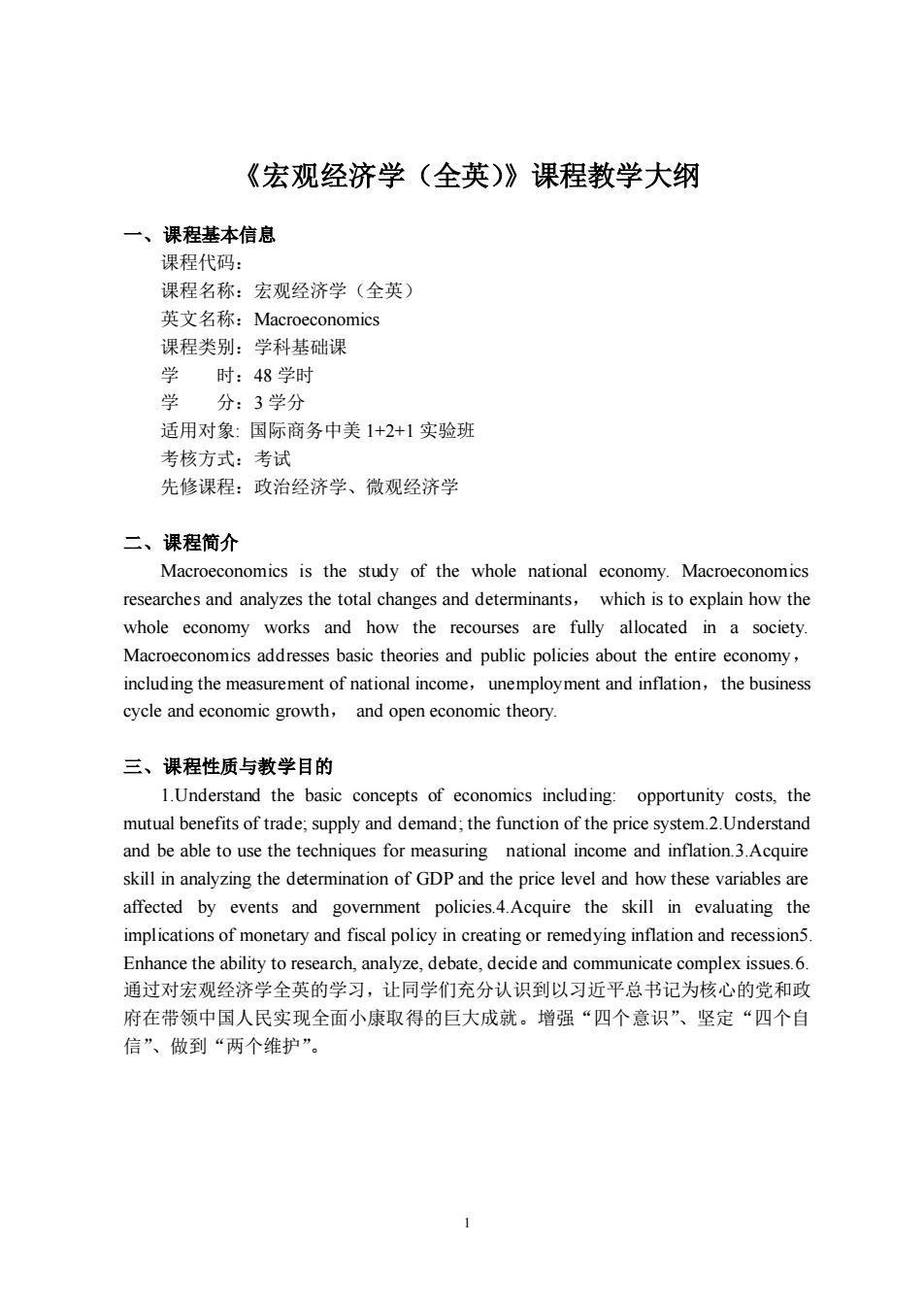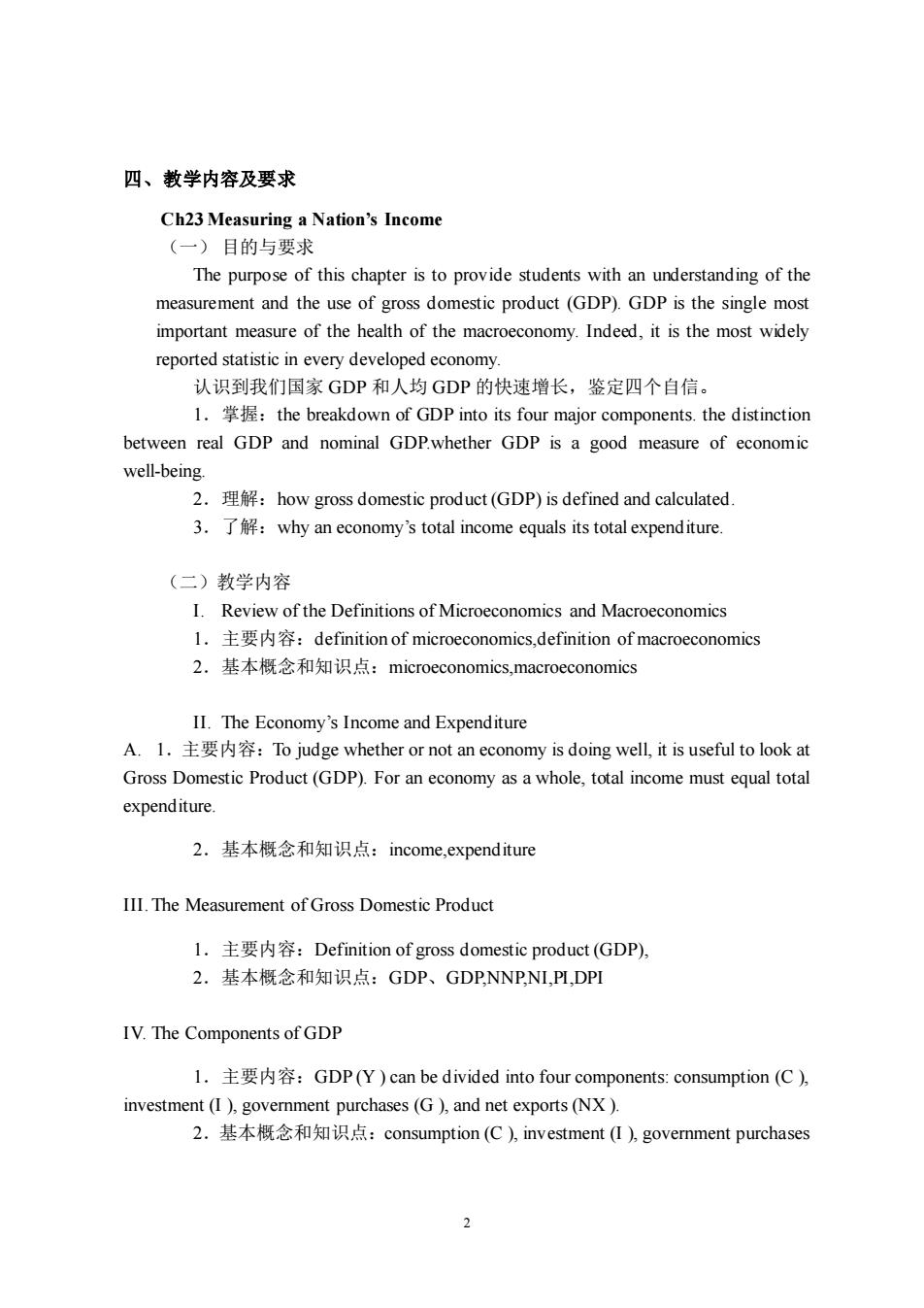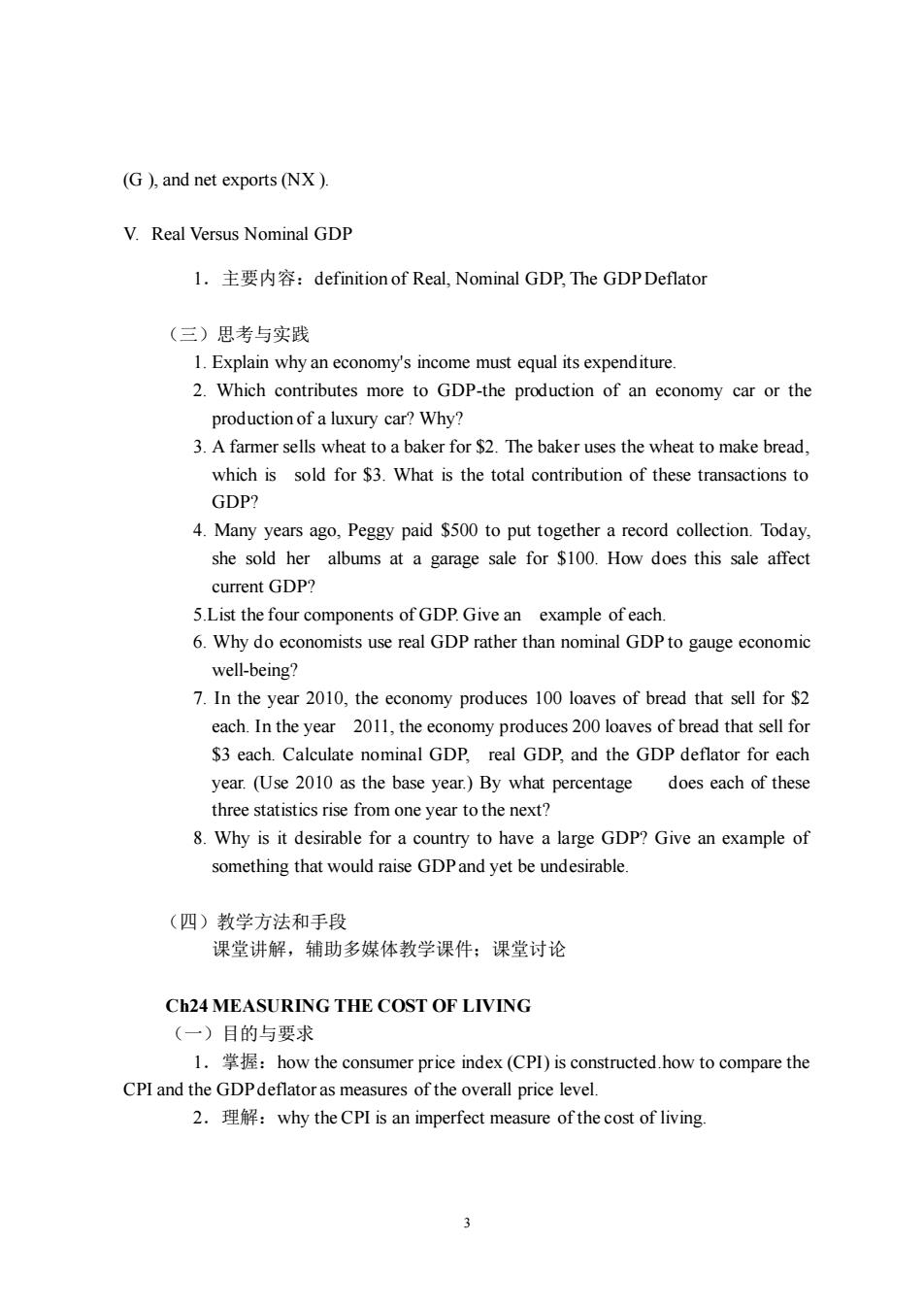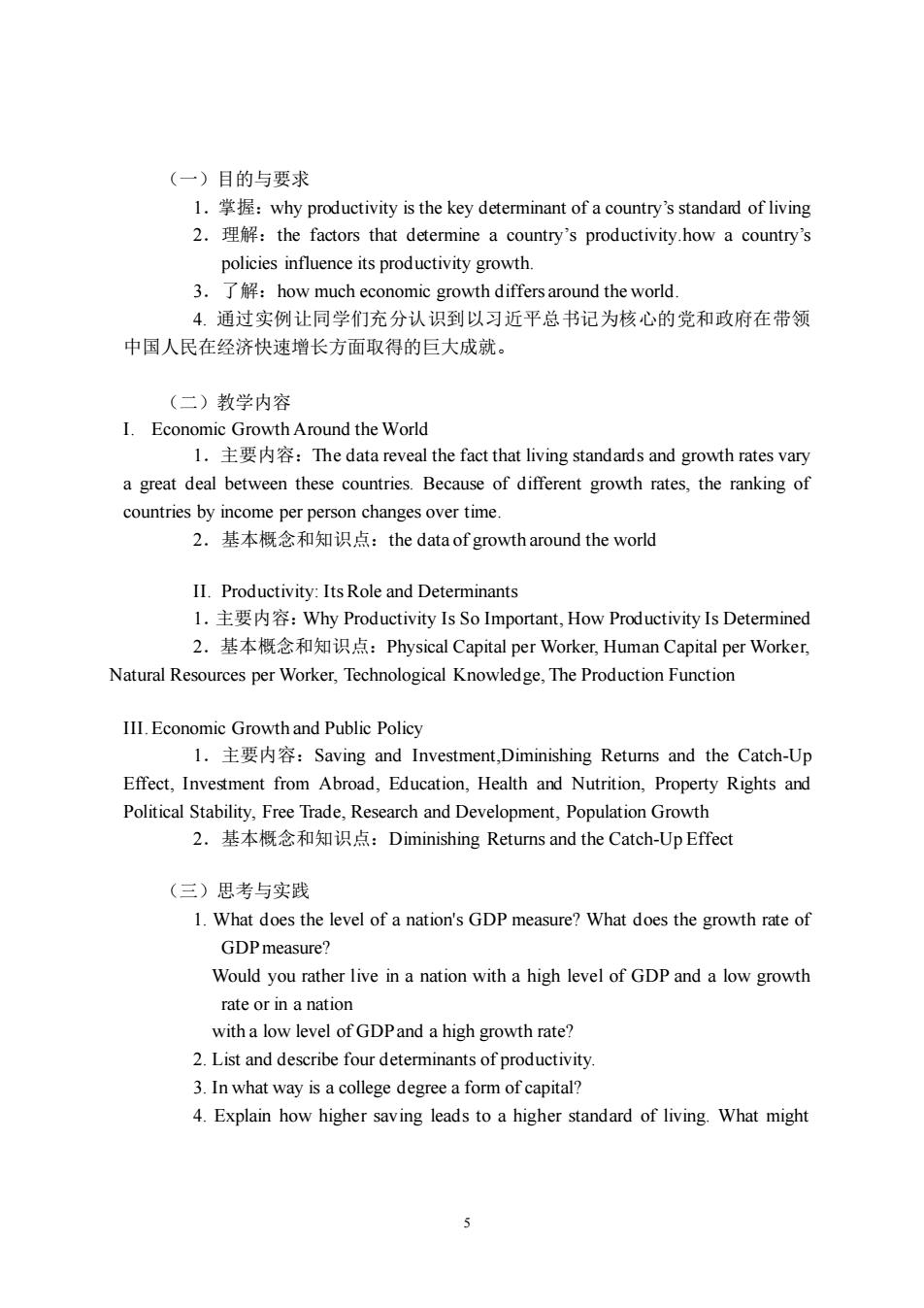
《宏观经济学(全英)》课程教学大纲 一、课程基本信息 课程代码: 课程名称:宏观经济学(全英) 英文名称:Macroeconomics 课程类别:学科基础课 时:48学时 学分:3学分 适用对象:国际商务中美1+2+1实验班 老核方式:老试 先修课程:政治经济学、微观经济学 二、课程简介 Macroeconomics is the study of the whole national economy.Macroeconomics researches and analyzes the total changes and determinants,which is to explain how the whole economy works and how the recourses are fully allocated in a society Macroeconomics addresses basic theories and public policies about the entire economy, including the measurement of national income,unemployment and inflation,the business cycle and economic growth,and open economic theory. 三、课程性质与教学目的 1.Understand the basic concepts of economics including:opportunity costs,the mutual benefits of trade;supply and demand:the function of the price system.2.Understand and be able to use the techniques for measuring national income and inflation.3.Acquire skill in analyzing the determination of GDP and the price level and how these variables are affected by events and government policies.4.Acquire the skill in evaluating the implications of monetary and fiscal policy in creating or remedying inflation and recession5. Enhance the ability to research,analyze,debate,decide and communicate complex issues.6 通过对宏观经济学全英的学习,让同学们充分认识到以习近平总书记为核心的党和政 府在带领中国人民实现全面小康取得的巨大成就。增强“四个意识”、坚定“四个自 信”、做到“两个维护
1 《宏观经济学(全英)》课程教学大纲 一、课程基本信息 课程代码: 课程名称:宏观经济学(全英) 英文名称:Macroeconomics 课程类别:学科基础课 学 时:48 学时 学 分:3 学分 适用对象: 国际商务中美 1+2+1 实验班 考核方式:考试 先修课程:政治经济学、微观经济学 二、课程简介 Macroeconomics is the study of the whole national economy. Macroeconomics researches and analyzes the total changes and determinants, which is to explain how the whole economy works and how the recourses are fully allocated in a society. Macroeconomics addresses basic theories and public policies about the entire economy, including the measurement of national income,unemployment and inflation,the business cycle and economic growth, and open economic theory. 三、课程性质与教学目的 1.Understand the basic concepts of economics including: opportunity costs, the mutual benefits of trade; supply and demand; the function of the price system.2.Understand and be able to use the techniques for measuring national income and inflation.3.Acquire skill in analyzing the determination of GDP and the price level and how these variables are affected by events and government policies.4.Acquire the skill in evaluating the implications of monetary and fiscal policy in creating or remedying inflation and recession5. Enhance the ability to research, analyze, debate, decide and communicate complex issues.6. 通过对宏观经济学全英的学习,让同学们充分认识到以习近平总书记为核心的党和政 府在带领中国人民实现全面小康取得的巨大成就。增强“四个意识”、坚定“四个自 信”、做到“两个维护

四、教学内容及要求 Ch23 Measuring a Nation's Income (一)目的与要求 The purpose of this chapter is to provide students with an understanding of the measurement and the use of gross domestic product (GDP).GDP is the single most important measure of the health of the macroeconomy.Indeed,it is the most widely reported statistic in every developed econom 认识到我们国家GDP和人均GDP的快速增长,鉴定四个自信。 1.:the breakdown of GDP into its four major components.the distinction between real GDP and nominal GDP.whether GDP is a good measure of economic well-being. 2.理解:how gross domestic product(GDP)is defined and calculated 3.了t解:why an economy's total income quals its total expenditure (二)教学内容 I.Review of the Definitions of Microeconomics and Macroeconomics l.主要内容:definition of microeconomics,definition of macroeconomics 2.基本概念和知识点:microeconomics,.macroeconomics II.The Economy's Income and Expenditure A..主要内容:To judge whether or not an economy is doing wel,it is useful to look at Gross Domestic Product(GDP).For an economy as a whole,total income must equal total expenditure 2.基本概念和知识点:income,expenditure III.The Measurement of Gross Domestic Product l.主要内容:Definition of gross domestic product(GDP), 2.基本概念和知识点:GDP、GDP,NNP.NI,PI,DPI IV.The Components of GDP L.主要内容:GDP(Y)can be divided into four components:consumption(C, investment(I),goverment purchases(G),and net exports(NX). 2.基本慨念和知识点:consumption(C).investment (I).government purchases
2 四、教学内容及要求 Ch23 Measuring a Nation’s Income (一) 目的与要求 The purpose of this chapter is to provide students with an understanding of the measurement and the use of gross domestic product (GDP). GDP is the single most important measure of the health of the macroeconomy. Indeed, it is the most widely reported statistic in every developed economy. 认识到我们国家 GDP 和人均 GDP 的快速增长,鉴定四个自信。 1.掌握:the breakdown of GDP into its four major components. the distinction between real GDP and nominal GDP.whether GDP is a good measure of economic well-being. 2.理解:how gross domestic product (GDP) is defined and calculated. 3.了解:why an economy’s total income equals its total expenditure. (二)教学内容 I. Review of the Definitions of Microeconomics and Macroeconomics 1.主要内容:definition of microeconomics,definition of macroeconomics 2.基本概念和知识点:microeconomics,macroeconomics II. The Economy’s Income and Expenditure A. 1.主要内容:To judge whether or not an economy is doing well, it is useful to look at Gross Domestic Product (GDP). For an economy as a whole, total income must equal total expenditure. 2.基本概念和知识点:income,expenditure III.The Measurement of Gross Domestic Product 1.主要内容:Definition of gross domestic product (GDP), 2.基本概念和知识点:GDP、GDP,NNP,NI,PI,DPI IV. The Components of GDP 1.主要内容:GDP (Y ) can be divided into four components: consumption (C ), investment (I ), government purchases (G ), and net exports (NX ). 2.基本概念和知识点:consumption (C ), investment (I ), government purchases

(G),and net exports (NX). V.Real Versus Nominal GDP l.主要内容:definition of Real,Nominal GDP,The GDPDeflator (三)思考与实践 1.Explain why an economy's income must equal its expenditure 2.Which contributes more to GDP-the production of an economy car or the production of a luxury car?Why? 3.A farmer sells wheat to a baker for $2.The baker uses the wheat to make bread, which is sold for $3.What is the total contribution of these transactions to GDP? 4.Many years ago,Peggy paid $500 to put together a record collection.Today, she sold her albums at a garage sale for $100.How does this sale affect current GDP? 5.List the four components of GDP.Give an example of each. 6.Why do economists use real GDP rather than nominal GDP to gauge economic well-being? 7.In the year 2010,the economy produces 100 loaves of bread that sell for $2 each.In the year 2011,the economy produces 200 loaves of bread that sell for s3 each.Calculate nominal gDp real gDp and the gDP deflator for each year.(Use 2010 as the base year.)By what percentage does each of these three statistics rise from one year to the next? 8.Why is it desirable for a country to have a large GDP?Give an example of something that would raise GDPand yet be undesirable. (四)教学方法和手段 课堂讲解,辅助多媒体教学课件课堂讨论 Ch24 MEASURING THE COST OF LIVING (一)目的与要求 1.:how the consumer price index(CPI)is constructed.how to compare the CPI and the GDPdeflator as measures of the overall price level. 2.理解:why the CPI is an imperfect measure of the cost of living 3
3 (G ), and net exports (NX ). V. Real Versus Nominal GDP 1.主要内容:definition of Real, Nominal GDP, The GDP Deflator (三)思考与实践 1. Explain why an economy's income must equal its expenditure. 2. Which contributes more to GDP-the production of an economy car or the production of a luxury car? Why? 3. A farmer sells wheat to a baker for $2. The baker uses the wheat to make bread, which is sold for $3. What is the total contribution of these transactions to GDP? 4. Many years ago, Peggy paid $500 to put together a record collection. Today, she sold her albums at a garage sale for $100. How does this sale affect current GDP? 5.List the four components of GDP. Give an example of each. 6. Why do economists use real GDP rather than nominal GDP to gauge economic well-being? 7. In the year 2010, the economy produces 100 loaves of bread that sell for $2 each. In the year 2011, the economy produces 200 loaves of bread that sell for $3 each. Calculate nominal GDP, real GDP, and the GDP deflator for each year. (Use 2010 as the base year.) By what percentage does each of these three statistics rise from one year to the next? 8. Why is it desirable for a country to have a large GDP? Give an example of something that would raise GDP and yet be undesirable. (四)教学方法和手段 课堂讲解,辅助多媒体教学课件;课堂讨论 Ch24 MEASURING THE COST OF LIVING (一)目的与要求 1.掌握:how the consumer price index (CPI) is constructed.how to compare the CPI and the GDP deflator as measures of the overall price level. 2.理解:why the CPI is an imperfect measure of the cost of living

3.:how to use a price index to compare dollar figures from different times.the distinction between real and nominal interest rates. 4.认识到中因政府在控制通货膨胀方面付出的巨大努力和取得的出色成就。 (二)教学内容 I The Consumer Price Index l.主要内容:Definition of consumer price index(CPI),How the Consumer Price Index Is Calculated,Definition of producer price index(PPI) 2.基本概念和知识点:CPI,PpI 3.问题与应用:Compute the CPI,.PPI,Problems in Measuring the Cost of Living 第二节Correcting Economic Variables for the Effects of Inflation l.主要内容:Dollar Figures from Different Times,Indexation l.基本概念和知识点:Indexation,nominal interest rate,real interest rate 2.问题与应用:To change dollar values from one year to the next (三)思考与实践 1.Which do you think has a greater effect on the consumer price index:a 10 percent increase in the price of chicken or a 10 percent increase in the price of caviar?Why? 2.Describe the three problems that make the consumer price index an imperfect measure of the cost of living. 3.If the price of a Navy submarine rises,is the consumer price index or the GDP deflator affected more?Why? 4.Over a long period of time,the price of a candy bar rose from $0.10 to $0.60 Over the same period,the consumer price index rose from 150 to 300. Adjusted for overall inflation,how much did the price of the candy bar change? 5.Explain the meaning of nominal interest rate and real interest rate.How are they related? (四)教学方法和手段 课堂讲解,辅助多媒体教学课件 Ch25 PRODUCTIONAND GROWTH 4
4 3.了解:how to use a price index to compare dollar figures from different times.the distinction between real and nominal interest rates. 4.认识到中国政府在控制通货膨胀方面付出的巨大努力和取得的出色成就。 (二)教学内容 I. The Consumer Price Index 1.主要内容:Definition of consumer price index (CPI),How the Consumer Price Index Is Calculated,Definition of producer price index (PPI) 2.基本概念和知识点:CPI,PPI 3.问题与应用:Compute the CPI, PPI, Problems in Measuring the Cost of Living 第二节 Correcting Economic Variables for the Effects of Inflation 1.主要内容:Dollar Figures from Different Times, Indexation 1.基本概念和知识点:Indexation, nominal interest rate, real interest rate 2.问题与应用:To change dollar values from one year to the next (三)思考与实践 1. Which do you think has a greater effect on the consumer price index: a 10 percent increase in the price of chicken or a 10 percent increase in the price of caviar? Why? 2. Describe the three problems that make the consumer price index an imperfect measure of the cost of living. 3. If the price of a Navy submarine rises, is the consumer price index or the GDP deflator affected more? Why? 4. Over a long period of time, the price of a candy bar rose from $0.10 to $0.60. Over the same period, the consumer price index rose from 150 to 300. Adjusted for overall inflation, how much did the price of the candy bar change? 5. Explain the meaning of nominal interest rate and real interest rate. How are they related? (四)教学方法和手段 课堂讲解,辅助多媒体教学课件 Ch25 PRODUCTION AND GROWTH

(一)目的与要求 1.:why productivity is the key determinant of a country's standard of living 2.:the factors that determine a country's productivity how a country's policies influence its productivity growth. 3.了解:how much economic growth differs around the world 4.通过实例让同学们充分认识到以习近平总书记为核心的党和政府在带领 中国人民在经济快速增长方面取得的巨大成就。 (二)教学内容 Economic Growth Around the World l.主要内容:The data reveal the fact that living standards and growth rates vary a great deal between these countries.Because of different growth rates,the ranking of countries by income per person changes over time. 2.基本概念和知识点:the data of growth around the world II Productivity:Its Role and Determinants l.主要内容:Why Productivity Is So Important,.How Productivity Is Determined 2.基本概念和知识点:Physical Capital per Worker,,Human Capital per Worker,. Natural Resources per Worker,Technological Knowledge,The Production Function III.Economic Growth and Public Policy I.主要内容:Saving and Investment,Diminishing Returns and the Catch-Up Effect,Investment from Abroad,Education,Health and Nutrition,Property Rights and Political Stability.Free Trade,Research and Development,Population Growth 2.基本概念和知识点:Diminishing Retums and the Catch-Up Effec (三)思考与实践 1.What does the level of a nation's GDP measure?What does the growth rate of GDPmeasure? Would you rather live in a nation with a high level of GDP and a low growth rate or in a nation with a low level of GDPand a high growth rate? 2.List and describe four determinants of productivit 3.In what way is a college degree a form of capital? 4.Explain how higher saving leads to a higher standard of living.What might 5
5 (一)目的与要求 1.掌握:why productivity is the key determinant of a country’s standard of living 2.理解:the factors that determine a country’s productivity.how a country’s policies influence its productivity growth. 3.了解:how much economic growth differs around the world. 4. 通过实例让同学们充分认识到以习近平总书记为核心的党和政府在带领 中国人民在经济快速增长方面取得的巨大成就。 (二)教学内容 I. Economic Growth Around the World 1.主要内容:The data reveal the fact that living standards and growth rates vary a great deal between these countries. Because of different growth rates, the ranking of countries by income per person changes over time. 2.基本概念和知识点:the data of growth around the world II. Productivity: Its Role and Determinants 1.主要内容:Why Productivity Is So Important, How Productivity Is Determined 2.基本概念和知识点:Physical Capital per Worker, Human Capital per Worker, Natural Resources per Worker, Technological Knowledge, The Production Function III.Economic Growth and Public Policy 1.主要内容:Saving and Investment,Diminishing Returns and the Catch-Up Effect, Investment from Abroad, Education, Health and Nutrition, Property Rights and Political Stability, Free Trade, Research and Development, Population Growth 2.基本概念和知识点:Diminishing Returns and the Catch-Up Effect (三)思考与实践 1. What does the level of a nation's GDP measure? What does the growth rate of GDP measure? Would you rather live in a nation with a high level of GDP and a low growth rate or in a nation with a low level of GDP and a high growth rate? 2. List and describe four determinants of productivity. 3. In what way is a college degree a form of capital? 4. Explain how higher saving leads to a higher standard of living. What might